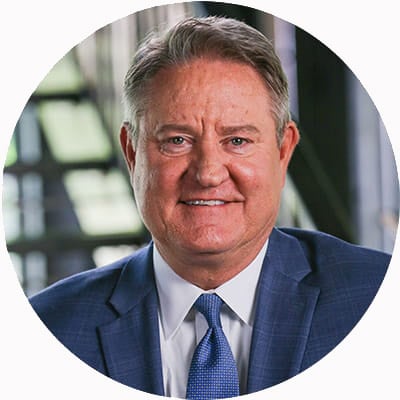
Moving beyond the shadow of the pandemic
Why we’re still feeling financial aftershocks, and what comes next
If you’re frustrated about higher interest rates and still-elevated inflation, there’s one thing to blame: the past.
In 2020, as an unprecedented global health crisis forced billions of people into at-home quarantine, the engines of economic growth ground to a near standstill. Determined to prevent a financial collapse, the U.S. government sprang into action to kickstart consumer spending and prop up businesses with massive stimulus packages. It worked—by most accounts, America narrowly averted an economic meltdown — but such extraordinary measures came at an extraordinary cost.
Today, while COVID-19 is far from eradicated, the widespread availability of vaccines has contained the threat and life has mostly returned to “normal.” The financial fallout of the pandemic, however, remains fresh on the minds of Americans. The U.S. economy is still dealing with the domino effect set in motion by the government’s crisis response, and it will be for the foreseeable future.
Brian Henderson, BOK Financial® chief investment officer, and Steve Wyett, BOK Financial chief investment strategist, weigh in on how the lingering effects of the pandemic response might affect the financial health of consumers, businesses and investors going forward.
1. What were the most important interventions the government made during the pandemic?

First, I think it’s important to remember that there was no pre-existing playbook for this type of global event; there were a lot of unknowns. However, based on lessons learned from the 2008 financial crisis, the government knew it needed to quickly make some bold moves to prevent a disaster. In March 2020, the self-imposed shutdown was already wreaking havoc on the financial markets, including liquidity challenges in U.S. Treasuries, which are normally a safe haven in turbulent times. The Fed responded by cutting interest rates to zero to spur economic activity. Meanwhile, Congress approved major fiscal stimulus spending packages, starting with the CARES Act, to support consumers, businesses and municipalities. These stimulus packages amounted to fiscal support of 10% of U.S. GDP in 2020, and another 11% in 2021, investing roughly $5 trillion of borrowed money into the economy.
Wyett: The Fed also quickly expanded quantitative easing (QE), essentially “printing money” to buy up Treasuries and mortgage-backed securities. This encourages banks to lend more freely, which stimulates economic growth. While the Fed has implemented QE several times since 2008, it went to unprecedented extremes in response to the pandemic. Incredibly, roughly 40% of all the money created in the history of the U.S. economy was introduced from 2021-2022. Such an aggressive move was warranted at the time but isn’t without consequences.
2. In what ways are we still dealing with the effects of the pandemic response?

Wyett: The short answer is “high inflation and interest rates.” Looking back, the big stimulus packages were meant to get people spending money. They accomplished that goal, but in a unique way. Since people couldn’t travel or go out to restaurants, they increased spending on at-home products, and that drove up demand for all kinds of goods. On top of that, many overseas ports and manufacturing facilities remained closed, which resulted in product shortages and other supply chain disruptions. These factors combined have played a big role in driving inflation over the past two years, and today we’re all feeling the pinch in our wallets. To slow down inflation, the Fed has raised interest rates dramatically since 2022, driving up the cost of borrowing for consumers and businesses.
Henderson: The pandemic’s impact on the labor market has also been a significant factor in shaping today’s realities. The lockdowns disrupted the workforce, and stimulus money allowed people to reevaluate their careers or retire altogether. The resulting shortage of workers has been another driver of inflation as businesses were forced to increase wages. Today, the labor market remains tight and small businesses, especially, are struggling to hire and cope with higher costs.
We can see lasting impacts in the real estate sector, too. On one hand, commercial real estate has struggled after the pandemic created a massive shift to work-from-home arrangements, many of which continue today. On the other hand, residential home values skyrocketed over the last few years as ultra-low interest rates created huge demand. Now, home prices are still sky high, but rates are too, which makes it extremely difficult for many families to afford a home.
3. What do these ongoing ramifications mean for investors?
Wyett: Inflation has abated somewhat, but we’re concerned another wave could be around the corner. As many companies re-shore parts of their operations to comply with legislation and gain more control over supply chains, the downside is likely to be higher prices.
Henderson: And as long as inflation remains high, so will interest rates. We don’t expect the Fed to make significant cuts any time soon. The good news is investors now have a big opportunity to take advantage of very attractive yields from fixed income instruments. It changes the game, because if you can, for example, get a 5% return on a relatively safe government bond, that sets the benchmark for evaluating all other investment opportunities.
Wyett: An ongoing high-rate environment may also result in a shake-out in some industries. When the cost of capital was extremely low, any company could grow and appear successful. However, as capital becomes scarce, well-managed companies will have opportunities to differentiate themselves. This means that investors will need to keep a close eye on company financials, and perhaps consider a more active approach to portfolio management.
4. From a financial perspective, when will we be able to say the pandemic is fully behind us?
Henderson: I think much will depend on how well the country is able to manage the enormous debts it took on during the pandemic. Our budget deficit is huge and the cost to service that debt continues to rise. Yet the government continues to spend at an alarming rate, both in an effort to support economic growth and to deal with geopolitical conflicts. As a nation, we will have to find ways to increase reliable sources of cost-effective energy, expand the labor force and increase productivity, all of which drives long term economic growth for our country. It may take years to make significant headway.
Wyett: In some ways, the pandemic could be seen as the Great Depression of our era. The people who lived through it will never forget it, and the policies that were implemented in response could reverberate across decades. The difference is we were successful in avoiding a catastrophic financial downturn, and the most extreme uncertainty is now behind us. For that reason, I’m extremely optimistic about the future. There are some headwinds to economic growth, but the current environment also holds some promising opportunities for investors.
2024 Annual Outlook
BOK Financial investment experts provide their outlook on key issues expected to affect the economy and financial markets for the year ahead.
